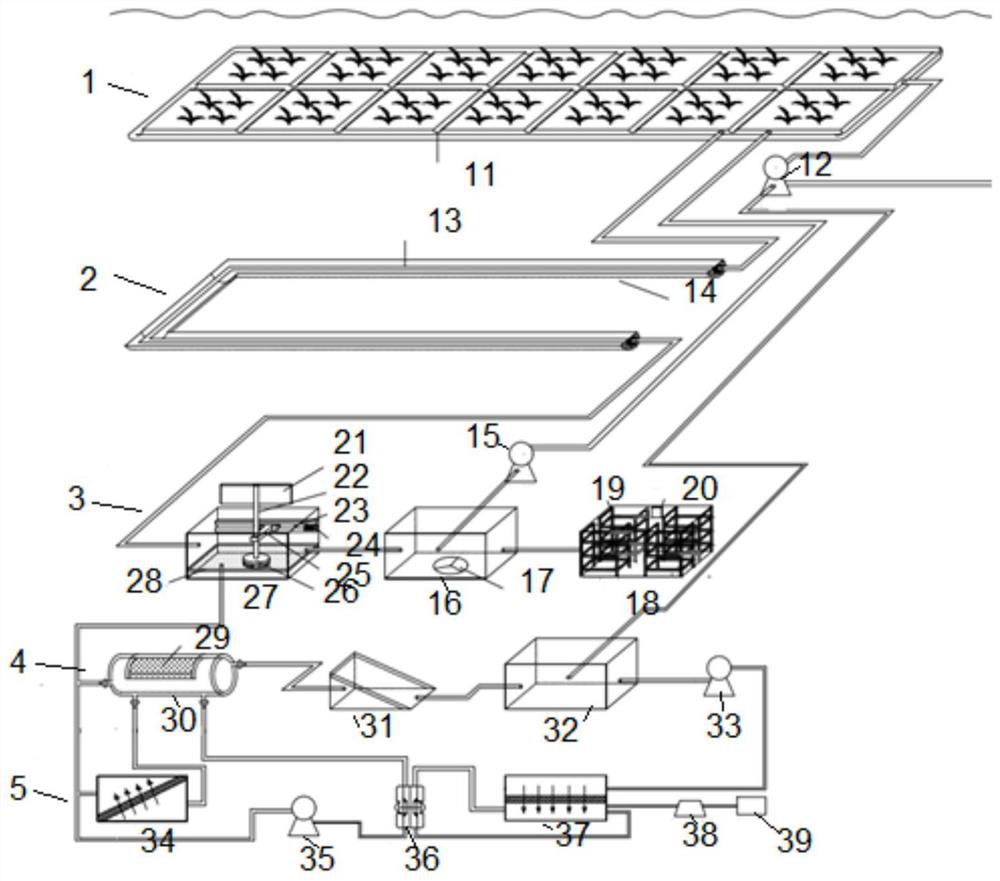A system and method for improving saline-alkali land through functional zone aggregates
A technology for saline-alkali land and aggregates, which is applied in land preparation methods, chemical instruments and methods, botanical equipment and methods, etc., can solve problems such as poor soil fertility, salt return, incomplete improvement, etc., to ensure clean, safe, rational and efficient use. , The effect of preventing salinization
- Summary
- Abstract
- Description
- Claims
- Application Information
AI Technical Summary
Problems solved by technology
Method used
Image
Examples
Embodiment 1
[0031] Such as figure 1 As shown, (1) Anti-return salt area 1:
[0032] Anti-salt return zone 1 is set at 10 meters from the sea, and a buffer zone of sand and soil is reserved to prevent backflow of seawater. Then, according to the size of the plant planting area, a water ditch with a width and depth of 0.5 m is set every 4 m in the horizontal and radial directions, and a drainage ditch 11 with a width and depth of 1 m is excavated outside the plant planting area. And drainage ditch 11 can be used to conserve water sources such as rainwater at ordinary times, and use as water inlet ecology. Suaeda salsa is planted in the planting area, and the number of plants planted in a single season per mu is controlled at 2,000 until the total soil salt is reduced to the target value. The stem parts of the planted Suaeda salsa are used to feed the barley worms in the auxiliary function area. The water inlet pump 12 is set to be connected with the sump 32 of the auxiliary function area ...
Embodiment 2
[0041] Such as figure 1 As shown, (1) Anti-return salt area 1:
[0042] Anti-salt return zone 1 is set 20 meters away from the sea, and a buffer zone of sand and soil is reserved to prevent backflow of seawater. Then according to the size of the plant planting area, a water ditch with a width and depth of 0.8 m is set at every interval of 6 m in the horizontal and radial directions, and a drainage ditch 11 with a width and depth of 1.2 m is excavated outside the plant planting area. Ditch and drainage ditch 11 can be used to conserve water sources such as rainwater at ordinary times, and use as water inlet ecology. Suaeda salsa is planted in the planting area, and the number of plants planted in a single season per mu is controlled at 2,500 until the total soil salt is reduced to the target value. The stem part of the planted Suaeda salsa is used to feed the barley worms in the auxiliary function area. The water inlet pump 12 is set to be connected with the sump 32 of the au...
Embodiment 3
[0051] Such as figure 1 As shown, (1) Anti-return salt area 1:
[0052] The anti-salt return area 1 is set 30 meters away from the sea, and a buffer zone of sand and soil is reserved to prevent backflow of seawater. Then according to the size of the plant planting area, a water ditch with a width and depth of 1 m is set at every interval of 7 m in the horizontal and radial directions, and a drainage ditch 11 with a width and depth of 1.5 m is excavated outside the plant planting area. And drainage ditch 11 can be used to conserve water sources such as rainwater at ordinary times, and use as water inlet ecology. Suaeda salsa is planted in the planting area, and the number of plants planted in a single season per mu is controlled at 3,000 until the total soil salt is reduced to the target value. The stem parts of the planted Suaeda salsa are used to feed the barley worms in the auxiliary function area. The water inlet pump 12 is set to be connected with the sump 32 of the auxi...
PUM
 Login to View More
Login to View More Abstract
Description
Claims
Application Information
 Login to View More
Login to View More - R&D
- Intellectual Property
- Life Sciences
- Materials
- Tech Scout
- Unparalleled Data Quality
- Higher Quality Content
- 60% Fewer Hallucinations
Browse by: Latest US Patents, China's latest patents, Technical Efficacy Thesaurus, Application Domain, Technology Topic, Popular Technical Reports.
© 2025 PatSnap. All rights reserved.Legal|Privacy policy|Modern Slavery Act Transparency Statement|Sitemap|About US| Contact US: help@patsnap.com

